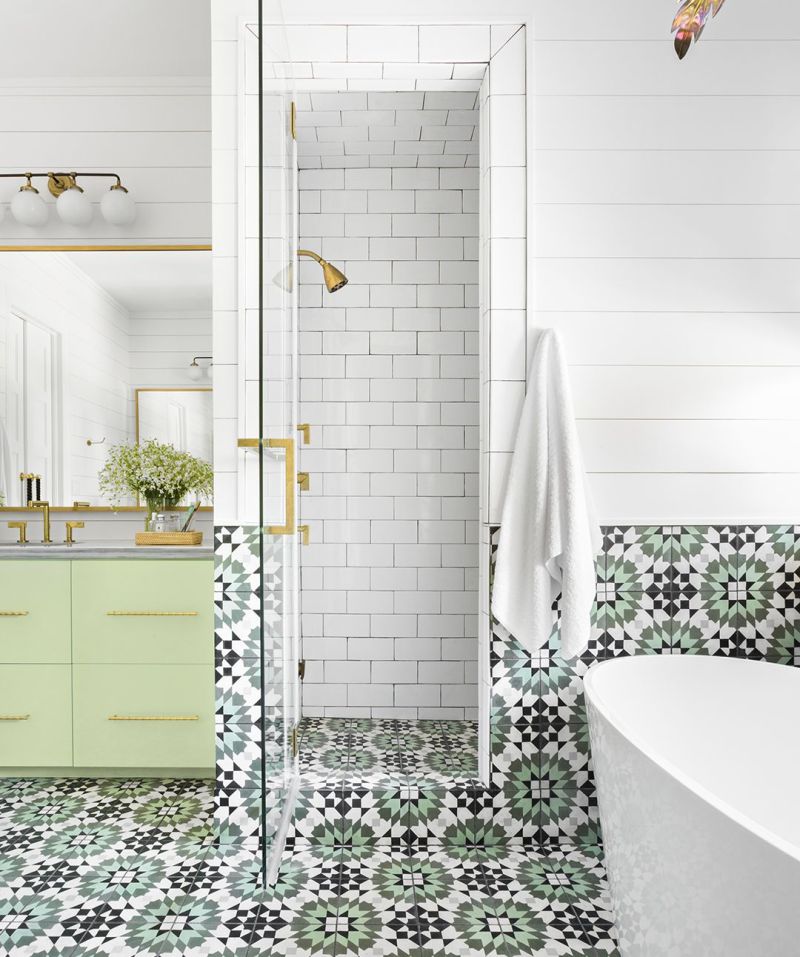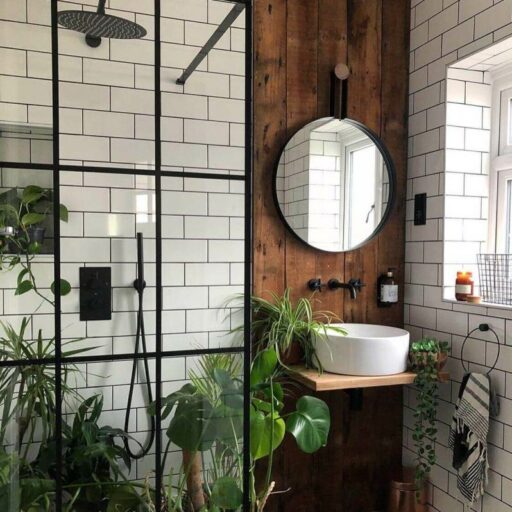What Kind Of Flooring For Bathroom – Believe it or not, the bathroom is one of the most important rooms in your home. A bathroom is a basic need for daily comfort and is an important element of every home, whether you live in it for a long time or are thinking about reselling it. So it’s no surprise that bathrooms are at the top of your priority list when you’re renovating your home, even more so than when you’re buying your first home.
However, these critical spaces have some special considerations when it comes to finishes, especially floors. And the main basis of these ideas is water. That’s right, water in its various forms can wreak havoc on your home, and the bathroom floor is often where most of the water collects.
What Kind Of Flooring For Bathroom

Whether it’s a splash, spill, leak, drip, or kids, the simple fact is that water will inevitably end up on your bathroom floor, walls, and even ceiling. This is absolutely necessary and the bathroom must be able to withstand liquid splashes.
Incredible Bathroom Tile Ideas To Inspire Your Next Remodel
For this reason alone, when considering a bathroom remodel, it’s a good idea to research your options and determine exactly what bathroom flooring is best for your project. There may be more to it than you think!
This article describes the most waterproof flooring options. Don’t know the difference between waterproof and waterproof? Water-resistant floors, as the name suggests, can withstand water, but water can seep into the floor and eventually damage it.
Consider water when choosing a floor.Waterproof floors are ideal for many rooms in your home. For example, the kitchen, basement, laundry room, mudroom, etc. Waterproof floors are generally cheaper than waterproof floors because the plywood or MDF core materials used in their construction are cheaper. However, these porous interior materials can also swell, warp, and peel when exposed to moisture. Imagine the top of a wood veneer glued to a sponge that is left to absorb water.
Waterproof floors are completely impermeable to water. Water can sit on the floor or seep into the surface of the floor, but it won’t damage the material or (perhaps more importantly) the subfloor. Waterproof floors are considered impermeable to water and moisture. The materials used to waterproof the floor also prevent moisture from penetrating, which also prevents mold from forming.
How Much Does Tile Flooring Cost? (2024)
With this in mind, waterproof options are actually the best choice when choosing flooring for your bathroom. Water-resistant floors can also be weakened by moisture and moisture, which is common in bathrooms. And in many cases, once these waterproof boards are damaged, they cannot be repaired, making complete replacement the only viable option.
We’ll cover the best options for waterproof floors, especially bathroom floors. After all, this article will give you great ideas for bathroom floors. But before that, let’s talk about what not to do. Instead of starting with a negative attitude, eliminate it first.
Again, nothing against Captain, but there are some flooring options you won’t want to choose for your next bathroom remodel. And perhaps they will surprise you.
Carpet is perfect for the softness of the soles of your feet. They come in a variety of loops, weaves, patterns, and colors. It’s cheap. Adds style and beauty to many rooms. It’s old and the bathroom is terrible.
Easy Diy: How To Install Sheet Vinyl Flooring Over Tile
If you grew up in the 1970s or 1980s, you may remember bathrooms with carpet. Carpet absorbs moisture from the air and water from drips and splashes, trapping moisture and causing mold to form. Mold can cause breathing problems and damage your floors. We won’t go into the germ factor, but as most people know, the bathroom is a happy place. Do you really need a bathroom floor that you can’t clean properly?
Hardwood floors are perfect for many areas of your home. It has a timeless look. Durability. Almost every room in the house can be renovated and features premium flooring that will last for decades. Almost not all. Do not leave it in the bathroom. To use hardwood in the bathroom, it must be carefully installed and completely sealed from moisture. Otherwise water will seep in and eventually rot. It’s also more likely that you’ll need to reseal it with a polyurethane-type coating than if it’s in another room that doesn’t have moisture issues, like a bathroom.
Laminate floors and engineered wood are also not ideal for bathrooms. There is a layer of real wood on top of the faux wood, but you also need to make sure it is completely sealed. The material underneath the wood layer is often not waterproof or even waterproof. This is the case with laminate floors, which are generally not compatible with water and any spills must be cleaned up immediately and there is a risk of them swelling or warping.
Please remember. The flooring experts at The Good Guys are always available to help you choose between waterproof and waterproof flooring, and the world of bad and good bathroom floors. Therefore, please feel free to contact us before starting your project. Hire the right people early and let our experience guide your product planning and selection.
Concrete Bathroom Flooring Review: Pros And Cons
Now, let’s take a look at some great bathroom ideas. This flooring is perfect for the most used rooms in your home.
It turns out that waterproof materials are important when choosing a good bathroom floor. This usually means a hard surface rather than a soft surface that holds water. Remember, distraction is the enemy – you, looking at the carpet.
The most popular choice for bathrooms is tiles. Ceramic and porcelain tiles are especially great for bathrooms. Tiles are flexible, waterproof, come in a variety of colors and designs, and are generally less expensive than other hard surface options. Ceramic tiles typically absorb less moisture than other ceramic products. Ceramic and porcelain pots are ideal for shower tiles because they can handle puddles and puddles.

Tiles have several features that some buyers often consider “cons.” Because tiles have a hard surface, they are sometimes referred to as “hard,” “cold,” or “sterile.” It’s true that standing on tiles for long periods of time can be uncomfortable, but this applies to any hard surface, and porcelain or ceramic are glossy floors so they can cope with floor temperatures. As for infertility, it’s amazing! Tile does not absorb water or bacteria and is easy to clean, making it ideal for sterile environments.
Shower Floor Tile Ideas For The Modern Kiwi Home
One potential drawback of tiles is that they can become slippery when wet, and bathrooms are usually constantly wet. However, this is not unique to porcelain or ceramic tiles. While this is true for many hard surface options, porcelain and ceramic tiles are often perceived to be more slippery than other surfaces because they are often fired smooth. For tiled floors, especially in shower stalls, look for tiles with textured surfaces for safety.
Another great option for bathroom floors is natural stone. There are a variety of natural stone options, from granite to marble and even limestone. Natural stone tiles have many of the same benefits as ceramic and porcelain tiles. Durable, water-resistant, and available in a variety of naturally occurring colors and patterns, this stone comes in the form of tiles, slabs, and even mesh-backed mosaics that hold together smaller tiles. Masu.
However, there are a few things to consider when considering stone as a bathroom flooring option. Installing stone can be difficult for DIY enthusiasts. Please keep this in mind if you try this project yourself. Stone, like tile, can be slippery, but grout patterns and finishes applied after “roughening” the surface can reduce this. Some stone products also require more regular maintenance than other options, as they require periodic application of sealants to maintain the stone’s finish and prevent dirt and debris ingress and moisture absorption. It may be necessary.
The biggest drawback for many customers looking for natural stone is the price. Natural stone provides a great finish to any bathroom, but it comes at a price. Stone is one of the most expensive types of flooring available. Because it is natural, it is a limited resource, and the extraction and production of stone flooring incurs additional costs.
Types Of Tile & Their Best Uses
However, vinyl is one of the cheaper bathroom flooring options. The “vinyl” category includes a variety of product configurations and is quickly becoming some of the most popular flooring options on the market today. WPC and SPC vinyl are the best waterproof options for bathrooms and other wet areas with high traffic. Vinyl looks like wood planks, stone, and even ceramic tile.
WPC and SPC vinyl flooring is a solid product that combines the durability, scratch resistance, and waterproof properties of vinyl. Usually comes in slabs, but sometimes in square tiles. The core of these products is made of a polymer compound of wood or stone and protected by a tread layer.


